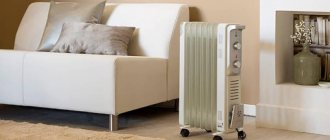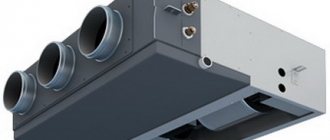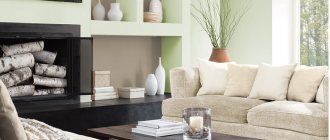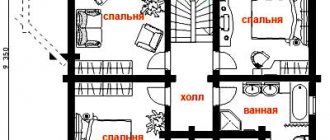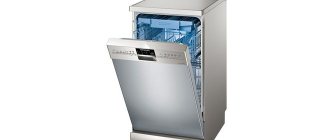A distinctive feature of multi-split systems for 2 rooms is the presence of two modules. One of them is located on the outside of the building, and the second consists of two blocks that are installed indoors in different rooms. Simply put, you can install 2 air conditioners in different rooms, and they will operate on the same external module. This option is especially relevant for new buildings, where only one place is allocated for the external unit, so as not to spoil the facade of the building, regardless of the number of rooms in the apartment.
Of the variety of climate control equipment on the market, wall-mounted models are the most popular, since they include a timer and temperature sensor.
What is a multi-split air conditioning system
In a classic split system, each internal module has its own external module. An apartment with several rooms will require 2 to 4 such devices. In some cases, such a scheme cannot be implemented. These include:
- lack of permits for the installation of several outdoor units;
- air conditioning of historical buildings in which it is necessary to preserve the original appearance of the facade;
- private construction: many external modules are not provided for in the architectural design and reduce the aesthetic impression of the building.
In this case, a multi-split scheme is used. In it, a single powerful outdoor module, installed in a permitted or inconspicuous place, serves from 2 to 4 indoor ones. Separate pipelines are laid to each of them from the external unit or from the intermediate manifold.
Installation of climate control equipment for 2 rooms
Installation of equipment has a number of difficulties, and therefore it is not recommended to install the system yourself. It is better to entrust this matter to qualified craftsmen, since the work process will require specialized equipment.
In some cases, it may be necessary to lay a route in the ceiling or wall, and therefore it is recommended to install the equipment during the period of repair work. Incorrect installation can significantly reduce the service life of the purchased equipment.
What is the difference from a conventional split system?
Functionally, from the user's point of view, a multi-split is not much different from a conventional air conditioner. The differences are as follows:
Installation features
Place the external unit in an authorized or inconspicuous place. Whenever possible, we try to minimize the total length of the routes.
It is necessary to provide for a sufficiently efficient drainage of drainage water - after all, the compressor power is increased, in proportion to the number of connected indoor units. (remove, does not depend, drain from each internal)
High-level systems include a distribution manifold; in low-end systems, pipes are laid from each internal module to the external one.
Number of premises served
Entry-level devices serve 2-4 rooms. Many manufacturers offer such models. The most powerful ones cope with 6-8 rooms.
Route length
For most models, the total length of the route is limited to 15 meters per indoor unit. In practice, this allows for 10+20 or 15+15 routing for two-room models. This allows you to cover all rooms facing one facade. In this case, the pipelines must be installed in one piece, without solder joints.
Price comparison
Despite the smaller number of parts and components, multi-splits are more expensive than separate split systems for the same number of rooms. This can be explained by the high requirements for the performance and reliability of the external unit.
VIDEO: Comparative analysis of split systems and multi-split systems -
Pros and cons of using
Traditionally, when purchasing an air conditioner, an outdoor module with a compressor is installed outside the building. A single indoor air conditioner is connected to it. If it is necessary to create an optimal microclimate not in one, but in several (2, 3, 5 or more) rooms, according to this logic, an external module will have to be installed on the outer wall of the building for each internal device.
If you live in an individual household, then problems usually do not arise. The only obstacle is that the decorative facade, hung with a number of bulky blocks (even in special boxes), does not look very attractive.
For residents of city apartments, this option is often simply unacceptable. Housing operating rules or legislation clearly limit the number of external blocks hung on the facades of buildings. This is usually one unit with limited dimensions. In some cases, a secluded corner on the technical floor or under the roof, in the niches of buildings, is even allocated for such purposes. As a rule, the size of the seat does not exceed 0.6 by 1.5 m. In such a technically difficult situation, the only way out is to use a system with one outdoor unit and several indoor units working with it (from 2 or more, depending on the number of rooms in the apartment ).
Using a multi-split system of the described type has both pros and cons. It is important to take into account all the nuances. Then climate control equipment will only delight you with its work.
Let's start with the advantages
- The external unit has great power and performance. Air exchange and the creation of an optimal microclimate can be carried out in rooms of various sizes.
- Low noise level during operation.
- An impressive range of indoor modules in different sizes and designs.
- Possibility of connecting internal elements in different versions to one outdoor module.
- Independence of the choice of power of individual elements from the outdoor unit. The main thing is that in total it does not exceed the total power of this block outside.
- The ability to create optimal conditions and climate in an apartment with a large number of rooms, when it is not possible to mount several separate modules on the wall of the building.
The disadvantages of this type of multi-split system include a number of factors.
- Difficulty in installing equipment, requiring the involvement of specialists.
- Installation is carried out on an ongoing basis. Changing the locations of modules in the future will be problematic.
- If the external unit breaks down (if the option with one compressor is selected), all rooms connected to it will remain without air conditioning.
- It is impossible to set different modes (air cooling/heating) in separate rooms. The problem is solved by purchasing an external unit with several compressors.
- The high cost of equipment (compared to the purchase of conventional air conditioners and the proportional number of external units) is obtained due to the use of innovative technologies in technically improved climate systems of this type.
Selecting a multi-split system
Consumers choose multi-split based on their capabilities.
The premium class includes Daikin and Mitsubishi Electric, which are uncompromising in performance and reliability. The costs of their acquisition will be recouped due to their long service life and energy savings. The reputation of these manufacturers is due to the quality of the build. high quality materials and components.
The middle class is represented by brands such as Haier, Hisense, Gree, Electrolux. This is a reasonable compromise between price and quality.
Budget installations produced by NeoClima, General Climate, Pioneer are most often installed by developers seeking to save every ruble. They use cheaper materials and simplified engineering solutions.
The reliability of such systems is beyond doubt, but the functionality will be reduced and the power consumption will be slightly higher.
The cost of installation is calculated taking into account the number of indoor units and the total length of the routes.
The best multi-split systems for 2 rooms
| Model | Price | Square | Noise level | Air cleaning | For allergy sufferers | Factory |
| The best multi-split systems for 2 rooms Hisense | ||||||
| Hisense AMS-09UR4SVEDB65 x 2 / AMW2-18U4SXE | RUB 83,050 | up to 50 m2 | Quiet (24 dB) | Weak | No | China |
| The best multi-split systems for 2 rooms Aeronik | ||||||
| Aeronik ASI-09 ILK3 x 2 / ASO-18 HMZK | RUB 70,725 | up to 50 m2 | Noisy (29 dB) | Super | Yes | China |
| The best multi-split systems for 2 rooms Haier | ||||||
| Haier AS09NS5ERA-W x2/3U19FS3ERA | RUB 139,500 | up to 50 m2 | Silent (20 dB) | Fine | No | China |
| The best multi-split systems for 2 rooms Daikin | ||||||
| Daikin ATXP20M x 2/2MXM40M | RUB 129,900 | up to 40 m2 | Silent (19 dB) | Weak | No | Europe |
| The best multi-split systems for 2 rooms Mitsubishi Heavy | ||||||
| Mitsubishi Heavy SRK20ZS-W x 2 / SCM40ZS-S | RUB 143,704 | up to 40 m2 | Silent (19 dB) | Fine | Yes | Thailand |
The best multi-split systems for 3 rooms
| Model | Price | Square | Noise level | Air cleaning | For allergy sufferers | Factory |
| The best multi-split systems for 3 rooms Aeronik | ||||||
| Aeronik ASI-07 ILK3 x 3 / ASO-24 HMZK | RUB 99,450 | up to 66 m2 | Quiet (24 dB) | Super | Yes | China |
| The best multi-split systems for 3 rooms Hisense | ||||||
| Hisense AMS-09UR4SVEDB65 x 3 / AMW3-24U4SZD | RUB 118,350 | up to 75 m2 | Quiet (24 dB) | Weak | No | China |
| The best multi-split systems for 3 rooms Haier | ||||||
| Haier AS07BS4HRA x3/3U19FS1ERA | RUB 142,600 | up to 60 m2 | Silent (20 dB) | Fine | No | China |
| The best multi-split systems for 3 rooms Mitsubishi Heavy | ||||||
| Mitsubishi Heavy SKM20ZSP-S x 3 / SCM50ZS-S1 | RUB 171,952 | up to 60 m2 | Quiet (24 dB) | Weak | No | Thailand |
The best multi-split systems for 4 rooms
| Model | Price | Square | Noise level | Air cleaning | For allergy sufferers | Factory |
| The best multi-split systems for 4 rooms Aeronik | ||||||
| Aeronik ASI-07 ILK3 x 4 / ASO-28 HMZK | RUB 118,125 | up to 88 m2 | Quiet (24 dB) | Super | Yes | China |
| The best multi-split systems for 4 rooms Haier | ||||||
| Haier AS09BS4HRA x4/4U26HS1ERA | RUB 198,400 | up to 100 m2 | Silent (20 dB) | Fine | No | China |
| The best multi-split systems for 4 rooms Mitsubishi Heavy | ||||||
| Mitsubishi Heavy SRK20ZS-W x 4 / SCM71ZМ-S1 | RUB 272,888 | up to 80 m2 | Silent (19 dB) | Fine | Yes | China |
Varieties
Modern multi-zone air conditioning systems (multi-split systems) are a set of equipment with one module for installation on the facade and two (or more) for installation in rooms, each of which is installed in a separate room. Air conditioning occurs through the operation of an inverter system, which is the most innovative. The devices use the latest developments in the field of climate control.
Equipment sets traditionally consist of a number of components.
- External module. Mounted outside on one of the walls of the building.
- Indoor units (2 pieces or more) for placement in rooms inside the house.
- A set of communications for combining and operating elements of climate control equipment with each other.
- Control panels, one of which becomes the main one.
In this case, you can buy a ready-made kit from one manufacturer, or you can assemble it yourself from the necessary elements. Pre-assembled multi-split systems include several types of indoor units: wall-mounted, console, cassette and floor-ceiling. For apartments, wall-mounted or floor-ceiling indoor units are often purchased.
There are also stationary multi-split systems with an outdoor unit equipped with two compressors. Such equipment can operate by simultaneously heating the air in one of the rooms and cooling it in the other.
Rating: TOP 12 best multi-split systems for apartments (from 2 rooms)
AERONIK
Aeronik ASI-09 ILK3 x 2 / ASO-18 HMZK
- Description: consists of 2 internal blocks, each of which is designed for an area of up to 25 sq.m. The total area of the two rooms is about 50 m2. It has a powerful Cold Plasma air purification system, a standard noise level of 29 dBa, low-temperature heating down to -20 C, a self-diagnosis function and an intelligent I Feel mode.
- Pros: effective filtration and self-cleaning function, R32 freon, Wi-Fi control capability.
- Cons: noisy.
Aeronik ASI-07 ILK3 x 3 / ASO-24 HMZK
- Description: consists of 3 internal blocks, each of which is designed for an area of up to 22 sq.m. The total area of the two rooms is about 66 m2. It has a powerful Cold Plasma air purification system, a standard noise level of 29 dBa, low-temperature heating down to -20 C, a self-diagnosis function and an intelligent I Feel mode.
- Pros: effective filtration and self-cleaning function, R32 freon, Wi-Fi control capability.
- Cons: noisy.
Aeronik ASI-07 ILK3 x 4 / ASO-28 HMZK
- Description: consists of 4 internal blocks, each of which is designed for an area of up to 22 sq.m. The total area of the two rooms is about 88 m2. It has a powerful Cold Plasma air purification system, a standard noise level of 29 dBa, low-temperature heating down to -20 C, a self-diagnosis function and an intelligent I Feel mode.
- Pros: effective filtration and self-cleaning function, R32 freon, Wi-Fi control capability.
- Cons: noisy.
DAIKIN
Daikin ATXP20M x 2/2MXM40M
- Description: a multi-split system with a powerful inverter compressor consists of two blocks. For best efficiency, it is recommended to install in rooms with an area of no more than 20 sq.m. It features a very low noise level of 19 dBa, multi-stage air purification, and an automatic fault diagnosis function. The air conditioner ensures efficient air distribution throughout the room and minimal electricity consumption. It is possible to connect to a Wi-Fi network via an additional module.
- Pros: reliable, economical and silent in operation.
- Cons: high cost.
HAIER
Haier AS09NS5ERA-W x2/3U19FS3ERA
- Description: multi-split system consisting of 2 indoor units, each with a power of 2.55 kW, suitable for rooms with a total area of up to 50 sq.m. Air conditioners have a powerful air purification and ionization system, plus a built-in ultraviolet lamp to neutralize bacteria and viruses. Control via Wi-Fi and the additional ability to connect an Oxygen Fresh unit to supply fresh air to the room.
- Pros: quiet operation, 3 color block options, UV lamp for air disinfection.
- Cons: none identified.
Haier AS07BS4HRA x 3/3U19FS1ERA
- Description: simple, but at the same time effective multi split system of 3 blocks. Designed for a total area of up to 60 sq.m. It has full inverter control, a low noise level of 20 dBA, an antibacterial filter, self-cleaning and a basic set of functions, including automatic operation and Intelligent Air.
- Pros: affordable price of the kit and almost silent operation.
- Cons: wi-fi module is an option.
Haier AS09BS4HRA x4/4U26HS1ERA
- Description: simple, but at the same time effective multi split system of 4 blocks. Designed for a total area of up to 100 sq.m. It has full inverter control, a low noise level of 20 dBA, an antibacterial filter, self-cleaning and a basic set of functions, including automatic operation and Intelligent Air.
- Pros: affordable price of the kit and almost silent operation.
- Cons: wi-fi module is an option.
HISENSE
Hisense AMS-09UR4SVEDB65 x 2 / AMW2-18U4SXE
- Description: inverter multi-split system with 2 indoor units for premises with a total area of up to 50 sq.m. It features inverter control technology, volumetric four-dimensional air distribution 4D Auto Air, multi-level cleaning of 3 filters, a comfortable noise level of 24 dB, a powerful 5-speed fan and the ability to heat down to -15 C.
- Pros: low price, stylish unit design, adjustable vertical and horizontal blinds from the remote control.
- Cons: no Wi-Fi control.
Hisense AMS-09UR4SVEDB65 x 3 / AMW3-24U4SZD
- Description: inverter multi-split system with 3 indoor units for premises with a total area of up to 75 sq.m. It features inverter control technology, volumetric four-dimensional air distribution 4D Auto Air, multi-level cleaning of 3 filters, a comfortable noise level of 24 dB, a powerful 5-speed fan and the ability to heat up to -15 C.
- Pros: low price, stylish unit design, adjustable vertical and horizontal blinds from the remote control.
- Cons: no Wi-Fi control.
MITSUBISHI HEAVY
Mitsubishi Heavy SRK20ZS-W x 2 / SCM40ZS-S
- Description: ultra-precise inverter system for 2 rooms, each with an area of 20 m2. Among the advantages, it is worth noting a powerful new generation rotary compressor, stable heating and cooling down to -15 C, a stylish design of the indoor unit with an easily removable panel, a self-cleaning mode, anti-allergenic enzyme and photocatalytic filters, two-segment blinds with a memory function and a weekly programmable timer.
- Pros: unique design for any interior, super quiet operation from 19 dBa, energy-saving mode, there is an additional Wi-Fi control option.
- Cons: more expensive than other analogues.
Mitsubishi Heavy SKM20ZSP-S x 3 / SCM50ZS-S1
- Description: premium class, total area of all rooms up to 60 sq.m., quiet operation from 24 dBa, compact dimensions and light weight, self-cleaning mode of the indoor unit, antibacterial fan coating, blinds memory, Silent operation function for additional comfort and reduction of outdoor noise block, auto defrost, increased route length.
- Pros: economical, reliable, instant cooling and heating function, works at -15 C, assembled in Thailand.
- Cons: no fine filters included.
Mitsubishi Heavy SRK20ZS-W x 4 / SCM71ZМ-S1
- Description: ultra-precise inverter system for 4 rooms, each with an area of 80 m2. Among the advantages, it is worth noting a powerful new generation rotary compressor, stable heating and cooling down to -15 C, a stylish design of the indoor unit with an easily removable panel, a self-cleaning mode, anti-allergenic enzyme and photocatalytic filters, two-segment blinds with a memory function and a weekly programmable timer.
- Pros: unique design for any interior, super quiet operation from 19 dBa, energy-saving mode, there is an additional Wi-Fi control option.
- Cons: more expensive than other analogues.
Features of the functioning of air conditioners
It is technically possible to connect up to 7 internal boxes to one outer box. There are no clear connections between the power of the outdoor unit and the number of indoor units. One external person can work in a company with either two or three internal ones.
When calculating the circuit, we proceed from the total power of all indoor units, which must fit into the range of min and max values of the outdoor cooling capacity (+)
Conventional multi-splits differ from expensive and advanced multi-zone installations by the inability of indoor units to operate in a heat-cold pair.
They can function only in one climate direction - either all for cold, or all for heat. If you turn on the units in opposite modes, the equipment will not start.
But you can set different temperatures on each device. But you need to stay within one mode - either cooling or heating.
How to choose the right place to place the outdoor unit
Few places have a technical balcony. The most convenient place to place the external module is next to the fire escape. Next comes a place next to the balcony, then under the window.
In these places they can be maintained without the involvement of industrial climbers, which significantly reduces operating costs.
Operating principle of the air conditioner
Any air conditioner operates using a liquid substance - freon, which is capable of either absorbing (during evaporation) or releasing heat (during condensation). The device ensures a change in the state of aggregation due to pressure and temperature, which allows the air to be cooled. Thus, when the refrigerant evaporates in the heat exchanger of the indoor unit, it takes away heat, and when it condenses in the outdoor unit, it releases it. The physics of the process is the transfer of heat from one environment to another (in the case of cooling, from indoors to outdoors).
The main parameter that needs to be taken into account when choosing such equipment is cooling capacity, or cooling power. This figure can be indicated either in kW or in special British thermal units (BTU). The dependence of power on cooling area is simple - per 1 sq. m. requires 1 kW (or 3412 BTU). On air conditioners from different manufacturers you can find two types of markings:
- BTU power index: 05 is 5000 BTU per hour, which corresponds to 1.5 kW and serves an area of 15 sq.m.;
- 07 – 7000 BTU per hour, productivity 2.1 kW for an area of 20 sq. m.;
- 09 – 9000 BTU per hour, 2.6 kW and 26 sq.m. etc.
- 20 – 2 kW, 20 sq.m.;
Air conditioner power is calculated based on the area of the room
Clearly limited power is the main problem that does not allow one device to cool several rooms at once. The air conditioner will qualitatively reduce the temperature only in an area corresponding to its parameters.
Selecting an installation based on characteristics
There is an opinion that a double split system should cost less than two separate appliances, but this is not true. Compared to the total price of two installations, one double installation will be 15-30% more expensive, even with the same power. The reason is the inverter operating principle.
Non-inverter air conditioners are cheaper and can be equipped with a winter kit. But there is little such equipment in the product range of manufacturers due to low demand.
Three types of indoor units
Internal modules of cassette, channel or wall type can be connected to the external unit. Let's consider when and in what rooms they are used.
The cassette unit is not suitable for rooms with low ceilings and/or small areas. These models are designed for large commercial premises - offices, restaurants, shops, cinemas.
Channel wiring also involves reducing the height of the rooms. This option is the most aesthetic, albeit expensive.
It would be appropriate in a country cottage, but not for two rooms, but for several rooms. You can make a common wiring with one or two external units.
Wall blocks are the optimal solution for an ordinary apartment or house with standard ceilings. They are easy to install and do not require large premises.
Technical parameters of devices
External units in double split systems are more reliable and the total length of their routes is longer when compared with conventional ones.
Indoor units are selected according to:
- power;
- range of outdoor temperatures;
- set of functions;
- length of communications;
- appearance.
The main functional parameter is the range of outdoor temperatures. It is important that the equipment operates in conditions that are below the maximum permissible. The efficiency of the equipment depends on the atmospheric load.
It is also important to consider the following three parameters:
- Corrections for additional heat inflows. Often, these coefficients require different indoor units for different rooms.
- The power of the outer box, which should be equal to the total cooling capacity of the indoor units plus correction factors. The outdoor unit may have 3 or 4 ports for connecting freon pipes, but only 2 are needed.
- Measurements of the maximum length of all freon pipes to the indoor units: each individually and the total number.
The disadvantages of the design include the need to install internal devices close to each other - next door. The distance depends on the length of the route in the selected model.
There is also a simplified formula: for 10 m2 you need about 1000 W of power. This calculation works for rooms with good thermal insulation. If the light enters the room from the south or southwest side, add another 25% to the indicators.
Manufacturers and models
Japanese companies Fujitsu, Mitsubishi, Toshiba are traditionally considered the most reliable manufacturers. They are also the most expensive brands.
The average price category is the Chinese General Climate and the Japanese Daikin. Budget series - Chinese Hisense, English-Chinese Dantex.
Of the 2-room models, you can consider the following:
- Mitsubishi Electric MSZ-HJ25VA-ER1×2/MXZ-2HJ40VA-ER1: for 50 m2 with deodorizing and anti-allergenic filter, low noise level of 20 dB, night mode.
- General Climate GC-M2E18HRN1: for 53 m 2, there is a mode of ventilation, self-diagnosis, drying, but no fine filters.
- Electrolux EACS/I-07HP+EACO/I-14 FMI-2: for 40 m 2, economical energy consumption, heating operates at temperatures down to –15 degrees.
- Fujitsu Inverter AOYG14LAC2: an external unit that can be equipped with budget internal ASYG07LMCA (15 m2) or large-area ASYG07LUCA (20 m2) and ASYG09LUCA (25 m2).
- Hisense AMW2-20U4SNC1/AMS-09UR4SVEDB6x2: for 50 m 2, two-way condensate drain connection is provided.
- Dantex RK-2M24SEGE: for 70 m 2, there is a system against ice formation, but it works for heating at temperatures down to –7°C.
The product lines include fixed and dial systems. The first ones imply a complete set from the manufacturer. In the second case, you can select the blocks yourself.
Indoor unit location for cooling multiple rooms
In an effort to save money or if it is impossible to install several external units, some try to position one powerful air conditioner so that it immediately cools 2 or 3 rooms. There are several common options here:
- placing the air conditioner in the corridor, provided that it has access to all rooms where cooling is required;
Often the air conditioner is placed in the corridor so that it cools several rooms at once - placing the device opposite the door in adjacent rooms so that the air flow from one room immediately enters the other.
Some install an air conditioner opposite the door to adjacent rooms so that one device cools several rooms at once
Such an arrangement is possible, but you should understand that it is simply not possible to achieve complete air cooling in several rooms at once. It's all about poor air exchange - even through an open door, no more than 10-15% of the cold will escape into another room, which makes it impossible to create a uniform temperature in the apartment. In addition, such an arrangement of the air conditioner entails a number of inconveniences:
- When installing in one room a device with a cooling capacity designed for the entire area of the apartment or several rooms, a too sharp temperature difference will form - in the room where the air conditioner is located it will be very cold, since its area is smaller than the potential of the equipment.
- Air conditioners have a thermostat that stops the cooling process when the temperature specified by the user is reached. Thus, a powerful device will quickly cool the room and stop, preventing the temperature in adjacent rooms from being fully reduced.


